Issue:May 2021
SPECIAL FEATURE - PFS & Parenteral Manufacturing: How COVID-19 Changed the Market
INTRODUCTION
The global prefilled syringes (PFS) market was valued $4.7 billion in 2019 and projected to reach $10.57 billion by 2026.1 And innovative and customized PFS are being introduced by market players that want to be key competitors in the global market.
PFS drug delivery is growing in preference over conventional vials because they facilitate benefits such as less risk of overfilling, safe and convenient use, ease of self-administration in a home setting, and lower cost per injection compared to vials or ampoules. “The growth of self-administered injectables is not surprising given the increasing need to reduce healthcare burden via self-administration,” says Eric Lee, Director, Business Development at Novocol Pharma. “This has created an opportunity to enhance the use of pens, PFS, and wearable devices. Markets are allowing for more and more injectable-based formulations to be developed for subcutaneous injection by self-administration.”
Currently, the majority of PFS are designed to be compatible with biologic drugs. “Year after year, the industry is seeing the increased use of biologics to fight chronic diseases and, in an effort to create better access for patients in non-clinical settings, the use of prefilled syringes has become the ‘gold-standard’ for easy and safe self-administration and convenience, particularly with more viscous biological products,” says Jeff Clement, Vice
President of Business Development, LSNE Contract Manufacturing.
Research on the global PFS drug molecules market shows that among drug classes, vaccines and insulin are expected to be top competitors during the forecast period. However, vaccines lead the market with a projected revenue of over $23 billion by the end of 2027 while insulin will have a higher growth rate.2 Experts agree this can be attributed to the COVID-19 pandemic.
“The COVID pandemic has accelerated the move to patient self-treatment and remote physician consultations,” says George I’ons, Head of Product Strategy & Insights at Owen Mumford Pharmaceutical Services. “Many patients are now more willing to treat themselves and manage their conditions with less face-to-face interaction with healthcare professionals. This set of circumstances has helped to drive the growth in autoinjectors and prefilled syringes as a method to self-administer medication.”
WEARABLE INJECTORS & CONNECTIVITY
Large-volume wearable for subcutaneous self delivery have become a preferred choice for administration of drugs in the homecare setting. Variants of these wearable devices have been designed to administer highly viscous drugs (such as biologics) in large volumes (more than 1mL), offering numerous dosing options (basal, bolus or continuous), integrated safety mechanisms, and an almost negligible risk of needlestick injuries. According to recent research, the field is witnessing innovation with the development of integrated mobile applications with smart health monitoring, artificial intelligence – including provisions for reminders, the ability to connect to web-based portals for sharing medical data with the concerned healthcare providers, visual/audible drug delivery confirmation notifications, automatic drug reconstitution, and error alerts. The researchers believe that such efforts will drive growth this market over the coming years.3
“The increase in remote patient treatment has driven the need for more drug delivery devices to offer the option of connectivity,” says Mr. I’ons. “In addition, the desire to improve therapy adherence and, in turn, hopefully improve patient outcomes is positively influencing this trend. Connected autoinjectors allow the simple transfer of key patient data on treatment time and dose delivery confirmation as well as the option to collect additional data. Connected devices now provide the means to create a ‘dialogue’ with the patient and provide training, education, and disease management information, and tools via apps. In the future, this technology will provide a variety of ways to increase engagement with patients as well as being able to identify issues with treatment regimens and provide the necessary corrective actions.”
ENVIRONMENTAL & COST CONCERNS
Despite myriad benefits, there are environmental and disposability concerns over single-use autoinjectors and PFS. This is increasing the need for products with sustainable features, environmentally friendly materials, and leaner and cleaner manufacturing processes and supply chains. Another hindrance in the growth of the PFS drug molecules market is being attributed to the premium pricing of autoinjectors. This is being linked to the complex development process.
This annual Drug Development & Delivery report explores how device developers and parenteral contract development and manufacturing organizations (CDMOs) are addressing these challenges, as well as advancements in customized device design, the continuous effort to incorporate safety and human factors, and how COVID-19 is shaping the future of the market.
AJINOMOTO BIO-PHARMA SERVICES – EXPANDING ASEPTIC FILL/FINISH CAPACITY
Increased demand for outsourcing parenteral CDMOs is being driven by the increasing number of emerging biopharma developing their own products through late stage. Additional demand is coming from the increase in targeted, potent, and orphan drugs as well as the continued growth of biologics.
Ajinomoto Bio-Pharma Services offers complete parenteral manufacturing services on three automated vial fill lines and one automated prefilled syringe fill line. In addition, the CDMO has an automated fill line, housing an inline lyophilizer, dedicated to highly potent products. Filling capacity with high speed is being expanded to include a high-speed, multipurpose fill line, which will be fully operational this summer.
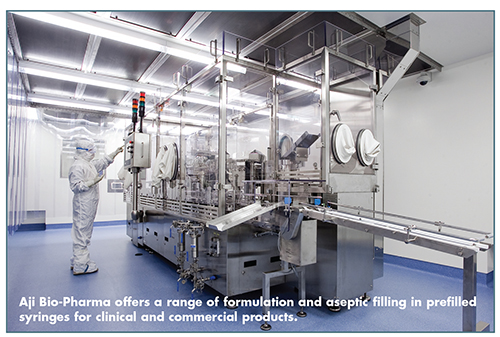
“This expansion provides a 50% increase in our current aseptic fill/finish capacity and allows for additional scheduling flexibility, as well as component flexibility,” says Reggie Branch, Manager, Drug Product Manufacturing, Ajinomoto Bio-Pharma Services. “The new fill line offers a range of configurations, including prefilled syringes, cartridges, and vials; utilizes isolator barrier technology to ensure the required sterility for fill finish; and uses ready-to-use components, which minimize component preparation and packaging.”
The increased need for CDMO services is also coming from the current focus on COVID-19 projects. In 2020, Ajinomoto Bio-Pharma Services partnered with a client that needed several lots to be produced to support ongoing COVID-19 efforts, and wanted to achieve delivery in the most efficient time possible. “They signed their first contract in April, and we were able to fill their first run by June,” says Mr. Branch. “There were several stakeholders that came together and worked very hard to meet this aggressive timeline without sacrificing quality. Ultimately, we produced approximately 45,000 vials for the client to be used during clinical trials with their patients.”
AMRI – IS 2021 THE YEAR OF THE PFS RECOLUTION?
Over the last year, all eyes have been on COVID-19. But the scientific community’s success in developing multiple, life-saving vaccines has had a ripple effect across the drug manufacturing pathway. These vaccines are now being produced by the millions, which has resulted in a vial manufacturing capacity shortage that is affecting other important areas of medicine. Fortunately, there is a solution that just so happens to come with ample positive side effects: prefilled syringes.
The advantages of PFS over traditional needle and vial delivery systems have been well-documented. PFS are easy to use and ensure accurate dosing. This makes them ideal for people with long-term conditions who must regularly self-administer medicines, such as monoclonal antibodies. Additionally, PFS reduce needlestick injuries and, because they deliver precise dosing, slash waste and the likelihood of potentially dangerous dosing errors, says Anish Parikh, Vice President, Drug Product Sales & Marketing, AMRI.

Further, Mr. Parikh says PFS are better suited than traditional vials for use in emergency situations and remote areas, enabling medicines and vaccines to be delivered, for example, by aid workers or support workers, with less medical expertise.
“Thanks to advances in filling technologies, PFS is now suitable for even more medication types than it was before, such as small-molecule drugs,” he says. “This leads some to believe that COVID-19 vaccines, currently being delivered via needle and vial, could soon make the shift to PFS. Any doses currently left in the vial after use are wasted, and as the vaccine roll out gains pace in low- to middle-income countries, healthcare systems will be looking to utilize non-medical staff to deliver doses. This means PFS has the potential to help manufacturers overcome the vial shortage, while enhancing safety and patient experience.”
Well-established PFS experts have the knowledge and the technology to work with partners to design processes for all types of medications. They have the technology – rotary piston, peristatic, or rolling diaphragm pumps – to meet the needs of even the most viscous or complex suspended product.
And, due to COVID-19, PFS experts have renewed focus on efficiency. AMRI, for example, has worked with pharmaceutical partners to slash lead times, in some cases from 15-18 months to less than 10. And, Mr. Parikh says AMRI also offers greater efficiencies via a full end-to-end service, from API processing to fill/finish.
“Those of us in the sector have known that PFS is the future for some time,” he says. “Over the last year, the wider industry, while driven by necessity, has also started to understand the added benefits this mode of delivery can offer when compared to traditional needle and vial systems.”
APIJECT SYSTEMS CORP. – NEW PFS MADE VIA BLOW-FILL-SEAL
Worldwide, the parenteral market is seeing greater emphasis on patient safety. This is driving a strong trend toward unit-dose formats, including prefilled syringes, which are now the fastest-growing format for injectables.
“A prefilled syringe eliminates the middleman, significantly reducing pharmacy staff workloads because there is no need to fill all those individual syringes,” says Beth Totin, Chief Commercial Officer at ApiJect Systems Corp. “Automated prefilling lessens the likelihood of medical dosing errors, reducing patient harm and reducing potential caregiver liability.”
ApiJect has developed a new prefilled injector that delivers these benefits while realizing significant economies of scale through Blow-Fill-Seal (BFS) manufacturing technology, explains Ms. Totin. “A single BFS production line can manufacture up to an estimated 25,000 of our unit-dose PFS devices per hour, potentially at a cost per dose delivered that is comparable to, or below that of, a multi-dose vial and associated disposable syringes.”
She notes that the ApiJect prefilled injector has been submitted for review, but has not yet been approved by FDA or other regulatory authorities.
Demand for primary packing of COVID vaccines has caused a significant number of fill/finish lines to reduce or halt production of regular vaccines to free up emergency capacity for COVID vaccines. ApiJect is addressing this challenge with a compact supply chain and high-speed, high-volume manufacturing. “Only pharmaceutical-grade resin and stainless steel are needed to make our prefilled injectors,” she says. “Both raw materials can be domestically sourced and stockpiled, reducing the risk of international supply disruptions.”
The future ApiJect Campus in Research Triangle Park, North Carolina, has been designed to deliver production capacity of 2 to 3 billion units annually with 15-plus BFS lines, each in a BSL-2 environment suitable for vaccines and a range of other injectable drugs. The first BFS line is expected to commence operations by late 2022.
APTAR PHARMA: VACCINE PLATFORM ADDRESSES COVID-19 DEVELOPMENT & LIFE CYCLE MANAGEMENT
The academic research, pharmaceutical, and medical technology industries have come together to develop, test, produce, and deliver COVID-19 therapies and vaccines. Aptar Pharma has been at the forefront of this response.
To date, 13 vaccines have received approval and many more are currently under development and trial. Regulatory approval is obtained not only for drug formulation but also for the primary container with which the drug is in direct contact. Therefore, choosing the right container and closure solution is essential to mitigate the risk in the development stage, obtain rapid approval to release the drug on the market, and secure the supply for large-scale delivery.
As vaccination campaigns are rolled out, the emergence of new COVID-19 variants suggests that, once under control, this pandemic could become a seasonal epidemic, says Audrey Chardonnet, Business Development Director, Aptar Pharma. “Drawing from our experience with the flu, we know seasonal vaccination is very different from the mass vaccination context we are currently experiencing. Instead of relying on large vaccination centers, where many vaccinations are performed sequentially, seasonal vaccines are usually administered by trained nurses, physicians or even pharmacists directly in their offices. In this context, single-dose prefilled syringes become highly relevant, as they limit drug waste compared to multidose vials and dramatically simplify the administration process. Preparing now for the transition from vials to prefilled delivery solutions is essential.”
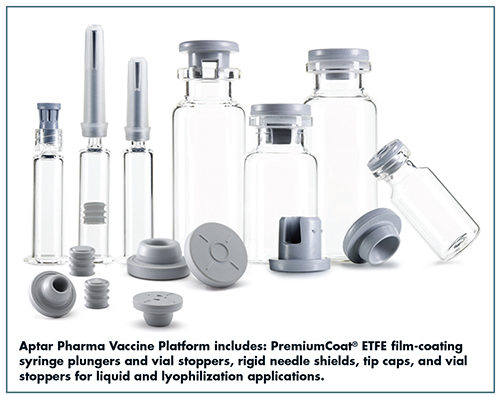
Aptar Pharma’s vaccine platform approach, which includes complete PFS closure solutions, rigid needle shield solutions for staked needles, and various tip-cap designs for luer applications, is designed to de-risk and accelerate pharma partners’ vaccine developments. Ms. Chardonnet explains that COVID-19 vaccine manufacturers are selecting Aptar’s PremiumCoat® stopper with state-of-the-art ETFE film coating technology to reduce risks linked to extractable and leachables, as well as for its performance in multi-piercing situations. “Our vaccine platform can support our pharma partners by delivering complete PFS closure solutions,” she says.
AUGUST BIOSERVICES – FULL-SERVICE CDMOS WILL MEET GROWING INDUSTRY DEMANDS
Prefilled syringes and parenteral contract manufacturing reside at a fascinating crossroads in 2021,” says Joe Mase, Executive Vice President of Operations for August Bioservices, a full-service, US-based, and injectables-focused CDMO. “In many ways, there has never been more momentum, strategic intent, and innovative product development behind ready-to-use, easy-to-administer drugs like prefilled syringes,” he says. “When you consider the benefits of patient safety, uniform dosing, and caregiver and patient convenience, prefilled syringes are understandably preferred mechanisms for drug delivery today. Yet, at the same time, these opportunities also are running into headwinds that could potentially stunt their production plans, launch schedules, and market adoption.”
Of course, COVID-19 has had a significant impact on the global contract manufacturing industry. Supply chains have been strained to the breaking point. Vetting of new potential vendors via on-site audits was restricted. The sourcing and delivery of critically needed materials, from API to components, have proven difficult, causing project timelines to shift beyond scheduled milestones and deadlines. Further exacerbating the problem is the dearth of available manufacturing capacity for prefilled syringes and parenteral manufacturing – especially in the United States. Moreover, a large portion of production slots that, under normal circumstances (in a non-COVID world), would have gone to a wide range of PFS products, have been allocated to producing vaccine.

Mr. Mase further explains the downstream impact. “While experts say a rise in chronic diseases is driving the injectables market, less widely understood and appreciated is the limited number of CDMOs with the requisite expertise and experience in injectable aseptic manufacturing to service this increasing demand efficiently and effectively. Fewer still have the equipment, capacity, and cGMP experience to successfully handle drug formulation development, clinical and commercial manufacturing, extractable and leachable testing, stability testing, terminal sterilization, as well as products that require lyophilization.”
BD – RECOGNIZING TRENDS IN VOLUME, DOSING, STORAGE, TRACEABILITY & PRODUCTION
As biologics are increasingly being considered for home self-administration, key design space parameters are evolving to encompass 2mL volumes (and more) with viscosities up to 30cP and beyond. These new formulations present design challenges, such as a potential increase in total injection time, patient discomfort, and issues with mechanical injection force. The BD InteviaTM 2.25mL disposable autoinjector platform combines a handheld autoinjector and a prefillable syringe in one integrated system, specifically designed for high-viscosity and/or higher-volume biologics. The integration of the BD NeopakTM XtraFlowTM 2.25mL glass prefillable syringe, featuring an 8mm extra-thin wall needle, supports injection of higher drug volumes and viscosities, and combination product performance. “With this solution, BD aims to enhance comfort, safety, and convenience for patients,” says Marie-Liesse Le Corfec, Global Portfolio Marketing Head, BD Pharmaceutical Systems.
Larger doses and higher viscosities are also trending as pharmaceutical companies respond to the move from intravenous to subcutaneous routes of administration, and from acute to non-acute care settings. Ms. Le Corfec says that multiple comparative studies show that patients and healthcare providers prefer subcutaneous to intravenous administration, citing improved clinical management, efficiency, and convenience with decreased pain and adverse effects. In response, the BD LibertasTM wearable injector has been developed to enable subcutaneous self- or care-giver administration of 2-10mL and up to 50cP viscosity. She says BD has conducted more than 50 preclinical and clinical studies to inform system design, measure performance, demonstrate the feasibility of 2-10mL subcutaneous injections, and characterize tissue response. The most recent clinical study with the investigational wearable injector demonstrated functional performance with broad acceptability across subject genders, body mass index categories, and age range, with and without movement.
Production capacity is a factor that could potentially restrain the injectables market. Recognizing this, BD is investing approximately $1.2 billion over a 4-year period to expand and upgrade manufacturing capacity and technology for prefillable syringes and advanced drug delivery systems across its 6 global manufacturing locations. A new manufacturing facility in Europe is also included in the investment package. “The investment will also fund new product innovations, manufacturing technology enhancements, and business continuity improvements, all designed to maximize supply and reduce risks for pharmaceutical companies that rely on ready-to-fill injection systems for their drugs — including biologics, vaccines, and small molecules,” Ms. Le Corfec says.
The BD Traceability program is a new dimension to the BD offer. BD will supply syringes identified with serial numbers, the hardware to read the serial numbers on pharma manufacturing lines, and the workflow/analytics software to process the data. She explains that the benefits for pharma customers of unit-level identification and automated container identification can include control of container integrity throughout the value chain and digital access to each container’s production data, intended to prevent product mix-ups prior to labelling, to automate batch segregation and reconciliation, speed up investigations, and limit the number of batches affected by a quality issue. The BD Traceability solution is meant to have no impact on customers’ existing production line speed.
A number of COVID-19 vaccines require frozen storage during deployment. BD is building on its experience with BD AccusprayTM Nasal Spray System for -25°C storage, as the company evaluates the performance of its PFS containers under deep cold storage conditions during the development and ongoing lifecycle management of the PFS containers.
BIOPHARMA SOLUTIONS – DEVELOPING & TESTING PFS FORMULATIONS
Advancements continue in the development and use of prefilled syringes. For example, an aging population and the increase of diabetes create a need for intravitreal injections. And aging patients diagnosed with macular degeneration and diabetic patients with decreased blood flow to the eye may find benefit in low-dose PFS to deliver biologics and steroids to the back of the eye.
Recent advancements in PFS provide more options for the market. This includes polymeric syringes that do not require application of silicone to the barrel of the syringe to allow easy movement of the plunger. Another is a hybrid syringe that is mostly polymeric with a fine application of a glass layer that decreases the water vapor transmission rate and the exchange of oxygen through the polymer. The syringe contains a plasma deposition layer of silicone that provides no free-silicone that could interact with the product or be deposited in the eye.
“BioPharma Solutions (BPS) is well experienced with developing and testing formulations in PFS, converting from a vial to PFS, as well as in understanding the details required for transferring ready-to-use syringes to the grade-A area,” says Gregory A. Sacha, PhD, Senior Research Scientist at BPS, a unit of Baxter. Controlling fill volumes and decreasing the variability in plunger placement are other services that BPS can service clients, he adds.
“The experience of our Bloomington, Indiana facility helped aid in producing prefilled syringes containing diluents such as sterile water for injection and sterile 0.9% saline for injection,” he explains. “The diluent injections are available in a range of volumes and can be paired with a product in a vial to ensure the exact volume of diluent is added.”
CATALENT BIOLOGICS – METHODOLOGY IMPROVES PROCESS DESIGN
PFS composition and design have been improved in the last year. Examples include: a low-tungsten forming process for glass syringes that helps avoid interactions with the biologic drug product and increases a product’s shelf-life; specific thin-walled needles that enable the injection of highly viscous biopharmaceuticals; and improvement of dose accuracy through a better management of syringe tolerances. Additionally, some autoinjectors have become e-Devices, with reusable electronic injection parts, and a design focused on patient ergonomics and safety.
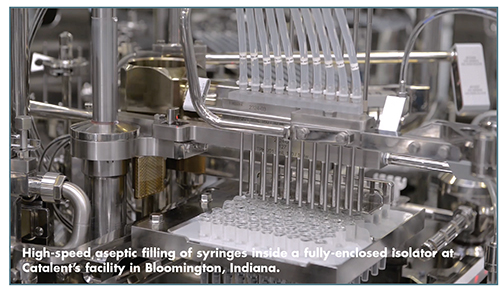
Catalent Biologics provides comprehensive global solutions from development and biomanufacturing to fill/finish of vials and syringes, device assembly, and packaging for pharmaceutical companies’ biologics and sterile injectables, beginning as early as the pre-clinical stage through commercial launch.
According to Natasha Van Rutten, Director, Product Development, Catalent Biologics, customers are coming to Catalent with different levels of cGMP and scale-up needed for the commercialization of a biologic or sterile product. “In order to ensure that products are developed or transferred in the appropriate method and timeframe, Catalent has created a complete methodology, ensuring that all critical data are either captured or generated in the early stages of the project,” she explains. “The data are managed so that the resulting manufacturing processes are appropriate, developed within the required timeline, and with the lowest level of risk.”
The methodology starts with a gap analysis, allowing the identification of what data are missing and needed to start the process design stage at the beginning of development or tech transfer. Using this methodology, Catalent supported a customer developing a PFS product that had severe clogging issues during drug product (DP) filtration prior to the filling step with its previous manufacturing partner. Through an appropriate gap analysis, it was demonstrated that certain critical information was missing for the DP. A Design of Experiment (DoE) was proposed and performed showing that a process parameter was not set appropriately, causing the clogging during filtration. Catalent’s scientific expertise solved the DP filtration problem and supported the successful commercial launch of the pharmaceutical drug.
CREDENCE MEDSYSTEMS – MEETING DIVERSE MARKET NEEDS
Two important factors influencing the injectable medication market are the continuing rise in the prevalence of chronic disease patients as well as the significant increase in vaccination requirements stemming from COVID-19. While the impact of each of these factors is significant, they represent different use cases and some different requirements.
The chronic care market is often characterized by injections occurring out of the formal healthcare setting by patients and their caregivers. A premium is placed on ease of use and user cues to help guide proper injections, and the market includes users who prefer an autoinjector as well as those who prefer the ‘direct injection’ from a syringe. On the vaccine side, injections are performed by healthcare providers, needlestick safety and reuse prevention are critical, and total cost of ownership constraints are often more stringent. Both markets share the need for minimizing the environmental footprint, maximizing a platform approach that yields consistency across both ready-to-inject formulations and those requiring reconstitution at the point of delivery, and compatibility with industry-accepted syringe barrels and closure components.
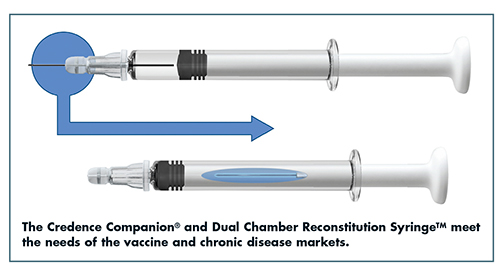
Credence MedSystems invented and developed its Companion® and Dual Chamber Reconstitution SyringeTM product lines to be flexible enough to meet the diverse needs of these markets, says John A. Merhige, Chief Commercial Officer, Credence MedSystems. Both products integrate with standard syringe barrels and use industry-standard closure components. “The Companion allows pharmaceutical manufacturers to provide critical usability and safety features to their end-users,” he says. At the completion of the injection, the user receives end-of-dose cues indicating that the full dose has been delivered, and the needle automatically retracts into the syringe barrel preventing reuse. “The Dual Chamber Syringe introduces the additional benefit of single-step mixing and injection, or the sequential injection of two liquids. Both products offer broad flexibility, a consistent user experience across the platform, a minimized environmental footprint, and potential compatibility with autoinjectors.”
Credence recently announced a strategic investment from Novartis intended to advance ongoing development and scaling of Credence’s drug delivery systems. Assisted by this investment, which confirms Novartis’ interest in employing Credence technology for its injectable medicines, Credence has initiated scaling of its manufacturing capability to meet customer demand. The production capability will include both the Companion and Dual Chamber products. An additional collaboration between Credence and SCHOTT for the application of Credence technology with SCHOTT’s prefillable glass and polymer syringes is directed at further ensuring readiness of the supply chain, he explains. “With multiple enabling strategic collaborations in place, Credence is poised to bring its innovative technology to the market to meet the complex needs of the vaccine and chronic disease use cases.”
DUOJECT MEDICAL SYSTEMS – OFF-THE-SHELF SOLUTIONS ARE BECOMING IMPRACTICAL
There is increasing interest for devices with performances tailored to specific formulation needs (i.e., fill volumes, injection volumes, injection time, needle requirements, container materials, etc.). This need is driven, in part, by the prolific development of complex drugs like biologics, the rise of home care treatments, and increasingly stringent regulations, says William Fortina, Business Development Director, Duoject Medical Systems. In response, device developers are focusing on simple-to-customize platforms; off-the-shelf devices or legacy systems (vials and syringes) are no longer appropriate, he says.
“Medical devices for parenteral administration must be capable of dealing with subcutaneous injections, viscous formulations, large injected volumes, controlled injection speeds, and thin needle gauges.”
In recent decades, pharmaceutical companies have been able to commercialize many small molecules, including generics, using off-the-shelf delivery systems. But, Mr. Fortina says increasingly specific treatments and complex molecules demand a customized approach to drug delivery system development, making off-the-shelf solutions less practical. “Approaching such projects requires a different mindset, which proved difficult for many players in the market,” he explains. “For instance, life-saving rescue autoinjectors in the US market must now be proven to be reliable 99.999% of the time with 95% confidence. The only way to achieve this is to collaborate closely with the device developer and manufacturers, as no off-the-shelf delivery system can achieve this without being developed and extensively tested hand-in-hand with the intended drug.”
When it comes to treatments for chronic diseases, injection requirements are becoming more drug- and patient-specific (i.e., less flexible formulations). Moreover, a growing amount of such treatments are aimed towards home care and self-administration. “Most off-the-shelf drug delivery systems cannot meet the injection and usability requirements of such treatments,” says Mr. Fortina. “For these reasons, medical device development or platform customization is often the only viable way. This is, and will remain, an important challenge to the commercialization of new treatments.”
The challenges described above lead many pharma companies to contact Duoject Medical Systems to develop devices for drug reconstitution and administration. Duoject has a large portfolio of patented platforms that can be customized to specific needs, but also offers end-to-end medical device development services. “There are many advantages to offering a medical device tailored for a specific treatment because it often results in fewer risks and a stronger presence on the market,” he says.
FLEX HEALTH SOLUTIONS – ELECTRONICS & HUMAN FACTORS ARE EQUALLY IMPORTANT
The proliferation of connectivity and app-based tracking of usage, dosage, and adherence is an important advancement in the PFS market. An exemplary smart syringe solution integrates a small electronic module, which transfers key information to a cloud-based system for further analytics.
Just as critical is the integration of sophisticated sensors to support proper positioning and use, which is helping to usher in the era of highly user-centric designs. The fast-growing, home-based healthcare market will require such patient-friendly designs.
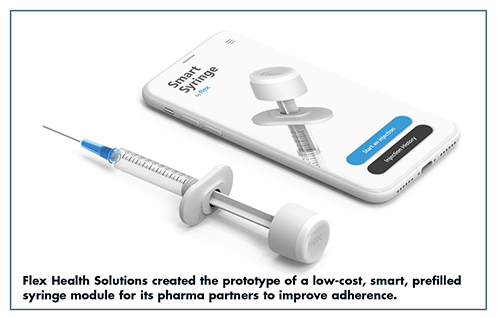
In fact, human factors are equally important to ensure ease of use. “We have worked with customers to consider the full patient journey and perspective: from the first step where the syringe is taken from the package and paired with a smartphone, to its handling at injection time, and finally to its environmentally friendly disposal,” says Marco De Angeli, Senior Director of Design, Flex Health Solutions. As a design-led CMO, Flex leverages and integrates core and emerging technologies, such as connectivity/Internet of Medical Things (IOMT), sensors/actuators, and printed batteries to optimize value in a range of medical products, including wearable injectors. Biologics that are traditionally delivered intravenously may be able to be delivered in a wearable pump applied by the patient. And personalized medicine, which makes the therapy more specific to the patient, may increase the need for various wearable pumps or other injectors that can be user filled, he says. Increased patient responsibility means that designs must be intuitive and easy to use. Here, again, human factors engineering built into the design is desirable and necessary.
Another trend is digitization of user interactions, where drug injection and environmental data are collected via sensors from the drug injection. The data is transferred to a backend medical mobile app/Cloud. “This allows the generation of customized therapies and direct interaction between doctor and patient,” says Mr. De Angeli. “Flex is working with customers to develop solutions for connected prefilled syringes that incorporate the latest interoperable low-power technologies (NFC-BLE) and is supporting customers in designing and developing machine-learning engines hosted as web services in a medical cloud engine.”
With connectivity comes concern about cybersecurity and the remote connection between medical devices and backend application. Flex helps customers mitigate cybersecurity risks by incorporating security into the device design, the mobile application, and the manufacturing infrastructure for smart prefilled syringe devices.
Because a prefilled syringe is disposable, cost must be factored into the system without compromising on quality and reliability, he stresses. “For cost effectiveness and a minimized footprint, the electronics should be fully integrated into a single silicon chip and have the right sensing and communication architecture. In demonstrating a proof of concept, Flex has created the prototype for a compact, low-cost add-on module, utilizing specialized engineering competences, such as radio frequency design, to optimize the antenna footprint, and sensor processing to achieve a reliable end-of-dose event.”
LSNE CONTRACT MANUFACTURING – RELIABLE & FLEXIBLE ASEPTIC FILLING
LSNE brings an integrated approach to pharmaceutical manufacturing of parenteral drug products. LSNE added PFS capabilities to its portfolio in 2019, and can support syringe sizes from 1-3mL with fill volumes as low as 0.1mL.
“We are seeing the market trend towards the increased use of prefilled syringes and anticipate continued market growth as the PFS presentation provides a host of benefits by limiting the waste of valuable drug product, allowing for precise administration, is user friendly and convenient for acute care or emergency use, improving safety, and are amenable to many autoinjector formats,” says Jeff Clement, Vice President of Business Development, LSNE Contract Manufacturing.

As the parenteral market continues toward an outsourced model, LSNE has made it a mission to provide consistency from formulation through aseptic filling. Its manufacturing suites are built with reliability and flexibility in operations, especially for complex formulations and high-value products that require minimal product loss. “LSNE meets all these challenges with a prefilled syringe line approved for both clinical and commercial products,” he says.
LSNE has experience with a range of drug product classes, including mRNAs, monoclonal antibodies, oligonucleotides, and challenging small-molecule therapeutics, as well as formulation methodologies such as liposomal formulations, non-aqueous formulations, suspensions, and emulsions.
MITSUBISHI GAS CHEMICAL COMPANY, INC. – PLASTICS WILL BE POPULAR THIS YEAR
“There is a shortage of glass containers because they have been used for COVID-19 vaccines so we expect the use of plastic containers will be more popular in 2021,” says Tomohiro Suzuki, Associate General Manager Business Development Department Advanced Business Development Division, Mitsubishi Gas Chemical (MGC) Company, Inc.
MGC supplies plastic containers, which have high water vapor barrier, very low extractables, low protein adsorption, high break resistance, and excellent pH stability, he says.
Mr. Suzuki says that there is increasing interest in ready-to-use plastic vials that feature cold storage resistance. “This is especially beneficial as biologics and drugs for gene and cell therapies are often stored at ultra-cold temperatures.
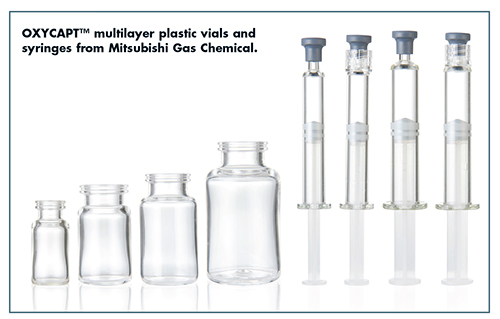
MGC’s OXYCAPTTM plastic vials are suited for parenteral pharmaceutical liquid medication storage. OXYCAPT’s multilayer construction preserves drug stability and shelf life in plastic vials, with significantly reduced oxidation, compared to cyclo olefin polymer (COP). Long-term trials find OXYCAPT eliminates the problem of delamination (visible small flakes and particles from glass deterioration over time) in glass, while maintaining its oxygen barrier. OXYCAPT also resolves poor stability and low visibility issues found in plastics, he says.
NEMERA – RANGE OF DEVICES EASE SELF-ADMINISTRATION
A rising number of pipelines in biologics and biosimilars require adequate drug delivery device solutions to accommodate sensitive drugs for safe self-administration. This has been exacerbated in the wake of the COVID-19 pandemic as patients are reluctant to visit hospitals to receive their therapies. Moreover, the switch from intravenous to subcutaneous drug administration in a home care therapy setting is emerging, driving the need for sustainable solutions. To cater to these needs, the pandemic drove digital health and sustainable solutions to come to light. With the converging trends of digitalization, electronics are being actively developed to be integrated within the drug delivery devices.
Nemera has bolstered its portfolio to address these trends and offers a range of parenteral delivery systems. Safe’n’Sound® is a highly customizable, passive safety device available in 1mL and 2.25mL formats, suitable for both skilled and novice users. An overcap, rigid needle shield (RNS) puller assists patients with dexterity issues, explains Severine Duband, Category Director, Devices, Nemera.
A range of Nemera pen injector platforms treat various pathologies thanks to the recent acquisition of Copernicus. A spring-assisted pen injector, coupled with a side-actuator button, enables users to stabilize the hand by resting it against the body during administration for seamless injection. “We understand the ergonomics for patient compliance and adherence to therapies is crucial,” she says.

Finally, a patient-focused on-body injector platform is designed for seamless and user-intuitive delivery of large volumes (20mL), with reusable and disposable parts for sustainability and cost efficiency.
“Through capabilities in human factors engineering, design research, user experience design, lab services, and regulatory support, Nemera can support customers with an integrated device platform and service program,” says Audrey Chandra, Category Project Manager for Nemera.
NOVOCOL PHARMA – Turnkey CDMO Supports Integrated Multi-Party Activities
Novocol Pharma specializes in sterile cartridge manufacturing. Over the past 5 years, and most recently, Eric Lee, Director, Business Development, has witnessed an incremental demand for cartridge-based injectables for self-administration. In fact, within the total injectable market, self-administered injectables consisting of cartridges-based pen injectors and PFS showed the largest growth.
As a sterile cartridge-focused CDMO, Novocol plays a key role in supporting the development and commercialization of the growing self-injection market. Its focus is on providing full turnkey services from product development support and tech transfer to fill/finish and final device assembly. “With our expertise and understanding of combination products, we assemble standard pen injectors using flexible in-house, pilot-scale assembly equipment and are also accustomed to running customized customer-dedicated assets,” says Mr. Lee. “With both GMP and ISO 13485 certifications, we are capable of providing a turnkey offering meeting the quality rigors for both drug products and medical devices. In addition, we have the necessary infrastructure to handle challenging product types including highly-potent APIs, controlled substances, and temperature-sensitive products.”
Given the additional complexities associated with both sterile injectable manufacturing and integration with a device for self-administration, it is highly challenging for pharma sponsors to manage and coordinate multi-party activities between the drug developer, CDMO, and device developer. Working with a CDMO and medical device developer who have previous project experience together can significantly reduce both timeline and quality risks in a development program, he says. Having this prior experience will allow a CDMO to adequately support device development- related activities, including early feasibility studies and design verification activities.
The CDMO can also collaborate with device developers to tailor drug product filling parameters to meet device-critical quality attributes such as break-loose and glide force, plunger insertion depth precision, and bubble size control. Finally, a turnkey CDMO will also be responsible for drug container/device integration, and must understand the critical quality requirements associated with the final device assembly steps.
OWEN MUMFORD – RECOGNIZING THE IMPORTANCE OF SAFETY DESIGN
With the continued growth in both biologics and biosimilars for subcutaneous delivery, these formulations present challenges related to volume of injection, viscosity, and injection time. Hence, there is an increased need to deliver higher volumes of biologics (greater than 1mL) via subcutaneous injection. This has led to the emergence of safety devices for 2.25mL PFS, enabling higher volume administration and the benefit of potentially less frequent injections for the patient. These safety devices are designed to prevent needlestick injury as well as enabling patients to administer medication at home.

“At Owen Mumford, we recognized the problems that result from the presence of springs in the design of safety devices for PFS,” says George I’ons, Head of Product Strategy & Insights at Owen Mumford. “Issues such as pre-activation in transit or before use, which ultimately impact the patient, were the motivation in developing the product and removing the spring from the design.” As a result, Owen Mumford’s UniSafe is a spring-free device, which has a less intimidating appearance and allows the user to clearly see and check the drug before use.
“We also realized that creating an integrated plunger that could not easily be removed from the rear of the syringe, especially during RNS removal, was key to preventing spillage and waste, and providing tamper evidence,” he says.
Solving these two issues, as well as creating a platform product that could address delivery of higher volume drugs or biologics lead Owen Mumford to create UniSafe in both 1mL and 2.25mL presentations. In addition, a desire to address sustainability concerns has resulted in development work to produce a reusable autoinjector with UniSafe 1mL at its core, which is expected to be on the market in 2022.
SCHOTT – GETTING PREPARED FOR COVID-READY PFS
The COVID-19 pandemic saw the rise of mRNA-based therapeutics. But a major challenge is the cold temperature storage and supply chain. mRNA degrades easily and in order to allow for injection in the human tissue, the mRNA is encapsulated in lipid nanoparticles. The shelf life of this complex system is prolonged by storing the drug at extreme low temperatures, as low as -80°C. These low temperatures provide new hurdles for the primary packaging.
Currently, most COVID-19 vaccines are launched in vials to allow for fast time-to-market. However, prefillable syringes could become a good alternative. Fewer drug preparation steps means a lower risk for medical errors. Additionally, single-dose PFS have the potential to minimize drug waste, compared to multi-dose vial packaging, which has a limited shelf-life once opened, says Tom van Ginneken, Senior Global Product Manager for SCHOTT. This becomes especially relevant with the potential outlook of a yearly re-vaccination – not at a vaccination center – but at the doctor’s office.

“While we see many benefits in the use of PFS for mRNA-based therapeutics, a PFS is a much more complex system compared to vials with more drug-contacting components: rubber plunger, rubber closure, lubrication layer, and in some syringes, the needle and glue,” he says. “And, little is known about how a PFS reacts to -80°C storage and transport. The rubber components used for the closure and plunger have different thermal expansion rates than the syringe material, and at the extremely low temperatures the elastic properties of the rubber components could be impacted, which may ultimately risk container closure integrity. Another challenge is the stability of the lubrication inside the syringe. This layer is typically a variation of silicone oil. After freezing and thawing, this silicone layer could create small particles that may impact the stability of the mRNA-encapsulated lipid nanoparticles.”
SCHOTT is investing $1 billion for capacity expansion across all pharmaceutical packaging product groups, and is working with mRNA biotech companies and universities to better understand the interaction between primary packaging and mRNA-based drugs. SCHOTT has characterized syringe functionality, sterility, and container closure integrity at extreme low temperatures of -80°C. As a next step, Mr. Ginneken says SCHOTT will investigate the lipid nanoparticle stability with glass syringes as well as cyclic olefin copolymer (COC) syringes.
“In combination with the analytical expertise from SCHOTT Pharma Services, SCHOTT is ideally positioned to help biotech companies choose the right pharmaceutical container or transition from vials into PFS,” he says.
TERUMO PHARMACEUTICAL SOLUTIONS – END-USER SAFETY IS TOP OF MIND
Increasing patient comfort during parenteral therapies is paramount at Terumo Pharmaceutical Solutions, which offers a comprehensive portfolio of needles, infusion sets, and primary packaging solutions.
“The patient is our end user,” says Katsuyuki Takeuchi, Associate Product Manager, Terumo Pharmaceutical Solutions. “Everything we do should always take into account the patient and we must always ask ourselves if we are improving things for end users. As we supply our products to pharma companies, we also rely on our customers to incorporate the patient’s perspective right from our first interactions on a project.”
Where possible, Terumo engages closely with patient groups to fully understand real-world challenges with drug and injection devices. Just recently, the Terumo team conducted a research project among the hemophilia community to see how its devices (in this case, safety-winged infusion sets) are used. “Our aim was to gather insights into the daily activities of patients and see where we could improve on the process of administering medication,” explains Mr. Takeuchi. “These important insights will fuel our future innovations and ensure the voice of the patient is embedded in the projects we pursue. Overall, the pharma industry is open to engage in multi-party discussions to support complex project discussions, and ultimately get products onto the market in an efficient way with reduced timelines.”
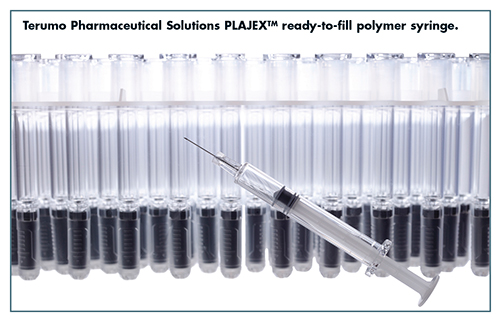
Again, with the patient top of mind, Terumo pays close attention to stringent regulatory scrutiny aimed at ensuring patient safety. Additionally, Mr. Takeuchi says there are changes in the regulatory landscape, like the change in the EU from the Medical Device Directive (MDD) to the Medical Device Regulation (MDR).
The new regulation is four times as long and the word safety appears 290 times, compared to 40 in the MDD. “These regulatory changes pose specific challenges to the industry and increased demand for customization,” he says. “With the uptake of small-scale/virtual biotech companies, which require additional support and services compared to global pharma players, we are in a position to offer a comprehensive documentation package to our customers to support them in their filing activities with the authorities. Regulatory filing, especially for combination products, requires close cooperation between all parties involved to make pathways to market shorter.”
There is also the issue of self-injection safety. Terumo’s PLAJEXTM primary packaging solutions offer the functionality and compatibility to deliver biologics and parenteral drug products.
The product is assembled with a 2-step autoinjector. Patients simply remove the cap and press the device onto the skin to complete the injection. The single-dose use medication is also suitable for elderly patients on continual treatment.
WEST – PATIENT NEEDS & COMPLEX DRUGS DRIVE DEVELOPMENT OF DELIVERY DEVICES
Because a large share of the global population is living with at least one chronic health condition – such as autoimmune disorders, cancer or diabetes – today’s patients have an increased need and a growing preference for easy-to-use, reliable, self-administered medications for frequent injections. Pharmaceutical companies are responding to these needs by rapidly developing new drug and delivery solutions. In fact, in the context of the COVID-19 pandemic where many patients are hesitant about in-person clinical visits, these innovative solutions can help patients manage their conditions safely at home.
Treatment options for chronic diseases are often managed through novel biologics. Biologics account for the majority of drugs in development pipelines and can be challenging to administer because of their complex structure and sensitive nature. Selecting the right materials for packaging and drug delivery is critical in improving stability and mitigating performance risks. Therefore, greater scrutiny is paid to the interaction between the drug and its container closure system. Drug stability over the shelf life, particulate burden, the prevention of breakage, and ease of delivery are important factors to consider. In addition, regulatory agencies and pharmaceutical companies have increased quality expectations to enhance patient safety.
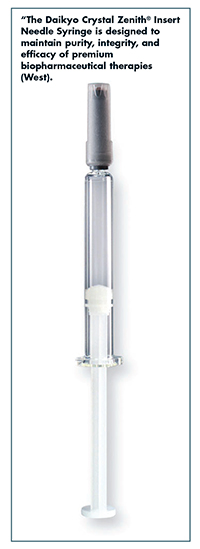
“Delivery systems based on cyclic olefin polymers (COPs) are becoming increasingly popular because these materials can meet the challenges of providing the quality, safety, and reliability needed for complex therapeutic applications,” says Dr. Nicolas Brandes, Director, Product Management, Polymer Prefilled Syringes and Vial Containment, West. “Benefits of COP-based syringes include break resistance, superior functional performance, highly reduced extractables, and low particulate burden.”
He adds that high-quality COPs, such as the Daikyo Crystal Zenith® syringe, are designed to overcome complex drug challenges, provide solutions for unique user requirements, and add value to complex and sensitive biologics. This includes the absence of silicone oil in Crystal Zenith syringes, which decreases interaction with the drug product and significantly reduces particulate load. “The Crystal Zenith Insert Needle Syringe supplied with a Daikyo Flurotec® piston is designed to maintain the purity, integrity, and efficacy of premium biopharmaceutical therapies,” says Dr. Brandes. “The Crystal Zenith Insert Needle Syringe, coupled with an autoinjector device, provides greater patient convenience and ease of use through self-administration.”
Finding fill-finish options for the broad variety of drug product packaging and containment options can be a challenge for drug developers. West provides fill-finish support services and assists with small-scale sample preparation for product testing, fill-finish implementation support, third-party clinical and commercial filling, analytical testing, and program management. “Having a single partner with these capabilities in fill-finish requirements for innovative containment systems, such as the Daikyo Crystal Zenith polymer syringe technology is critical,” he says. “Using a pharmaceutical services partner with experience in support services can reduce development and supply risk, reduce total cost of ownership, and accelerate a path to market. West’s Simplify the JourneyTM process does exactly that: it partners with drug developers from concept and development, through to analytical testing, assembly, and regulatory filing, to streamline the commercialization of drug delivery systems – no matter the complexity.”
Crystal Zenith and Daikyo Flurotec are registered trademarks of Daikyo Seiko, Ltd.
REFERENCES
- Prefilled Syringes Market Size, Share & COVID-19 Impact Analysis, 2020-2027, Fortune Business Insights, https://www.fortunebusinessinsights.com/industry-reports/prefilled-syringes-market-101946.
- Prefilled Syringes Drug Molecules Market, Prefilled Syringes Drug Molecules Market: Governmental Move to Increase Vaccination Coverage to Boost Market Revenue Growth During the Forecast Period: Global Industry Analysis (2012 – 2016) & Opportunity Assessment (2017 – 2027), Future Market Insights, https://www.futuremarketinsights.com/reports/prefilled-syringes-drug-molecules-market.
- Large Volume Wearable Injectors Market (5th Edition), 2020-2030: Focus on Bolus, Basal and Continuous Delivery Devices, ResearchandMarkets, July 24, 2020, https://www.globenewswire.com/news-release/2020/07/24/2067186/0/en/Global-Large-Volume-Wearable-Injectors-Market-Outlook-to-2030-with-Competitive-Analysis-on-400-Players.html.
Total Page Views: 21126









